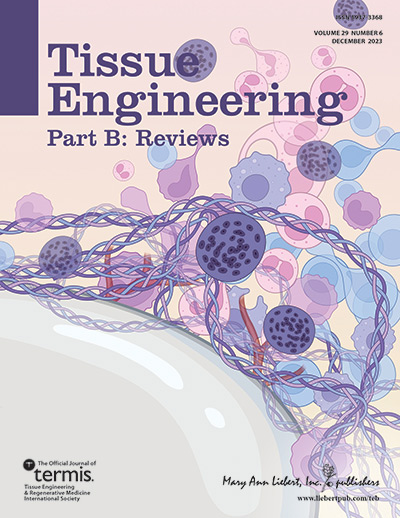应用挑战:基于 DAT 的水凝胶支架的凝胶化策略。
IF 5.1
2区 医学
Q2 CELL & TISSUE ENGINEERING
引用次数: 0
摘要
脱细胞脂肪组织(DAT)具有丰富的来源材料、天然细胞外基质(ECM)微环境和非免疫原性等特性,使其成为组织工程领域的一种多功能资源,因此具有极大的临床适用性。然而,实际应用却面临着多种限制。其中,选择合适的凝胶化策略是适应不同临床环境的基础。不同物理或化学条件下的交联策略对 DAT 的最终形态和疗效有着深远的影响。本综述总结了 DAT 的脱细胞和后续凝胶化过程,特别强调了近期 DAT 实验应用中采用的各种凝胶化策略。综述阐述了不同凝胶化策略的方法、基本原理和临床意义,旨在为 DAT 在组织工程中的应用提供见解和灵感,推动组织工程支架开发研究。本文章由计算机程序翻译,如有差异,请以英文原文为准。
Challenges in Application: Gelation strategies of DAT-based hydrogel scaffolds.
Decellularized Adipose Tissue (DAT) has great clinical applicability, owing to its abundant source material, natural extracellular matrix (ECM) microenvironment, and non-immunogenic attributes, rendering it a versatile resource in the realm of tissue engineering. However, practical implementations are confronted with multifarious limitations. Among these, the selection of an appropriate gelation strategy serves as the foundation for adapting to diverse clinical contexts. The crosslinking strategies under varying physical or chemical conditions exert profound influences on the ultimate morphology and therapeutic efficacy of DAT. This review sums up the processes of DAT decellularization and subsequent gelation, with a specific emphasis on the diverse gelation strategies employed in recent experimental applications of DAT. The review expounds upon methodologies, underlying principles, and clinical implications of different gelation strategies, aiming to offer insights and inspiration for the application of DAT in tissue engineering and advance research for tissue engineering scaffold development.
求助全文
通过发布文献求助,成功后即可免费获取论文全文。
去求助
来源期刊

Tissue Engineering. Part B, Reviews
Biochemistry, Genetics and Molecular Biology-Biochemistry
CiteScore
12.80
自引率
1.60%
发文量
150
期刊介绍:
Tissue Engineering Reviews (Part B) meets the urgent need for high-quality review articles by presenting critical literature overviews and systematic summaries of research within the field to assess the current standing and future directions within relevant areas and technologies. Part B publishes bi-monthly.
 求助内容:
求助内容: 应助结果提醒方式:
应助结果提醒方式:


